Explore research activity
Icing: software development
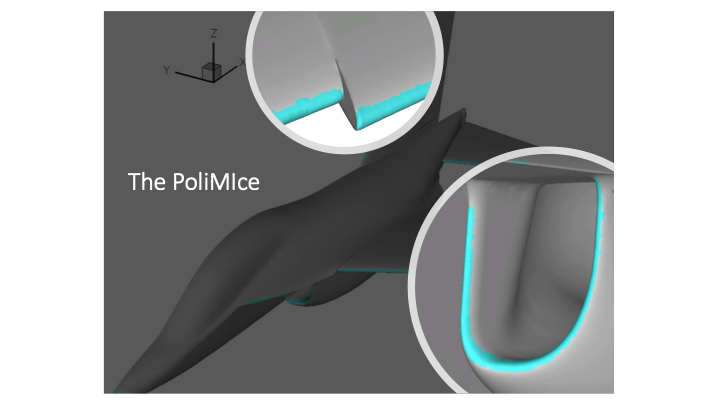
Since the early beginning of my Academic career, I have been actively involved in the development of computational solvers for predicting ice accretion in aeronautical applications and wind energy. I started working on ice accretion simulation solvers while developing my Msc Thesis at Politecnico di Milano PoliMIce: un ambiente di simulazione per la previsione dell’accrescimento di ghiaccio su velivoli. The PoliMIce suite is a full three-dimensional ice accretion engine capable of performing icing simulations targeting complex geometries such as, for instance, a complete airframe. Thanks to its highly modularity, the PoliMice can be easly coupled to several CFD solvers, for the solution of the aerodynamic field, and for the reconstruction of droplet trajectories. The PoliMIce suite is now employed in several European research projects e.g., UTOPIAE (Uncertainty Treatment and OPtimisation in Aerospace Engineering, H2020 MSCA- ITN, ESR10: Uncertainty Characterisation in Multi-fidelity Anti-ice system and Design. Website: http://utopiae.eu), NITROS MSCA-ITN (Network for innovative training on rotorcraft safety, H2020 MSCA European Joint Doctorate, ESR1: Simulation and prevention of ice formation and shedding on rotorcraft) and H2020 ICE-GENESIS project (WP9, WP10, WP11) coordinated by Airbus.
Icing: accretion models
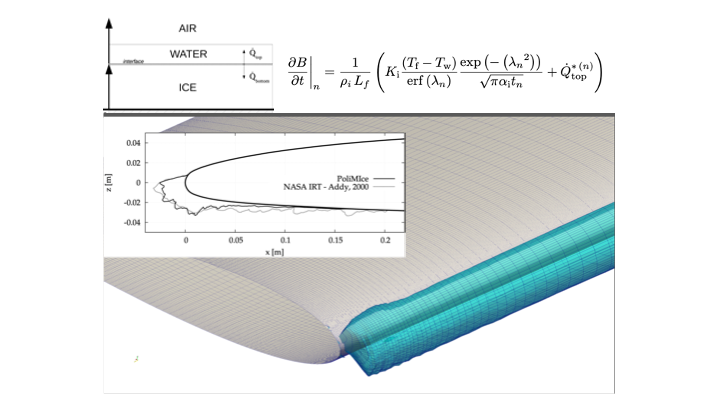
One of my earliest research interests is the modeling of the ice accretion mechanism for aeronautical and wind energy applications. Under the physics perspective, the ice accretion phenomenon corresponds to a three-phase problem involving air, water and ice. The complexity of the icing mechanism lies in the difficulty of correclty modeling the properties of the ice structure and the dynamics of the thin water film flowing over the ice surface. Typically, the ice layer forming over the airframe contains small air bubbles that remain trapped due to the fast dynamics of the water liquid-to-solid phase transition mechanism. This leads to the formation of a not homogeneous structure and, of course, to a difficulty in defining properties such as the thermal diffusivity, the density, the surface roughness and so on. In this context, I have been particularly interested in modeling the heat diffusion within the ice layer [1, 2, 3].
Icing: uncertainty quantification
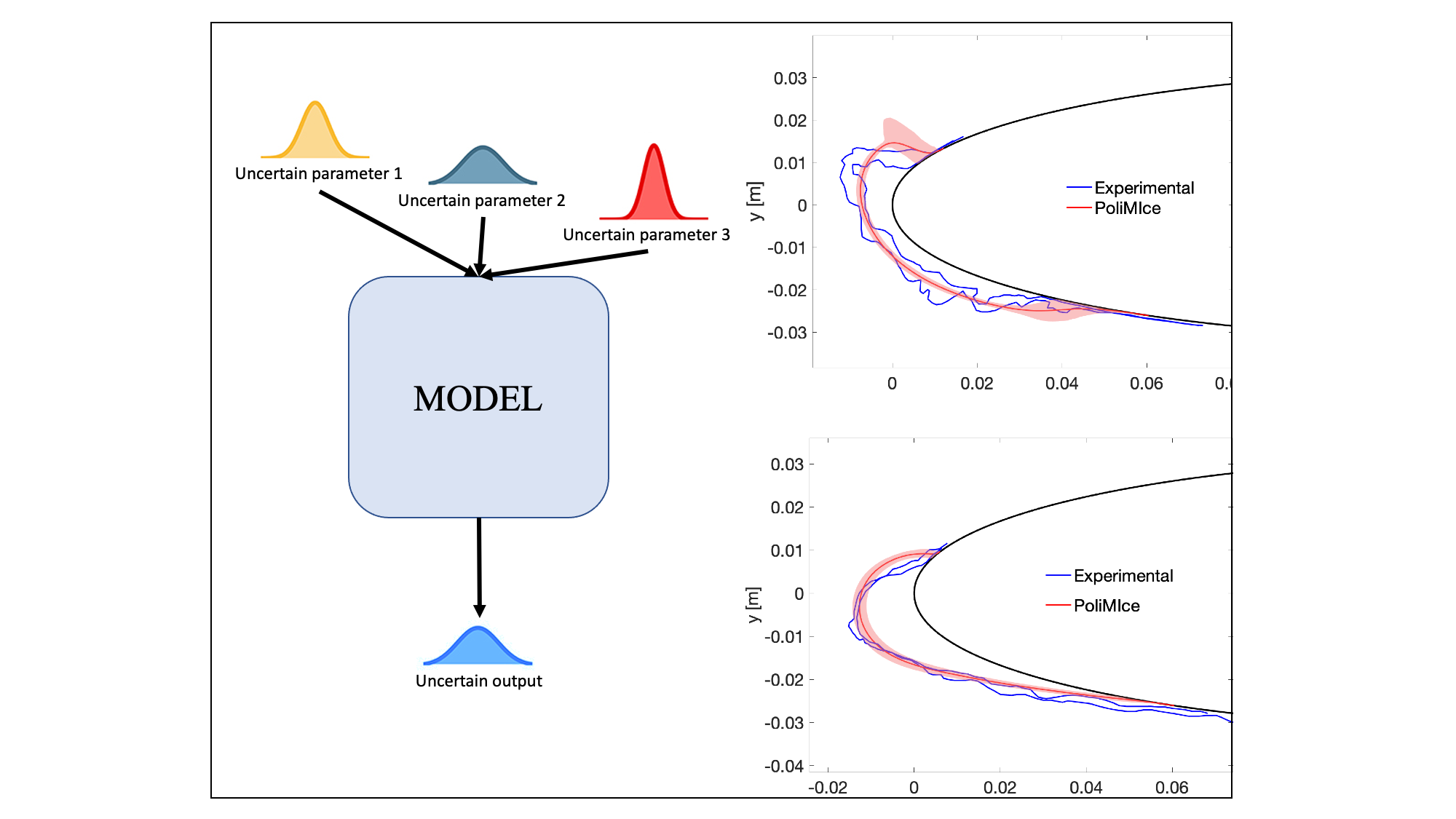
Unfortunately, our understanding of reality is unavoidably affected by uncertainty which questions the credibility of computational models and, ultimately, the reliability of numerical predictions. This is particularly true for in-flight ice accretion, which abides by complex physical laws challenging standard Uncertainty Quantification (UQ) techniques. Being capable of generating predictions under uncertainty is of the utmost relevance for enhancing the robustness of in-flight ice protection systems and the aircraft certification process. The complexity of the icing mechanism prevents modeling the properties of the ice structure within a deterministic framework. Indeed, the ice layer forming on the airframe during a cloud encounter typically contains small air bubbles that remain trapped due to the fast dynamics of the water liquid-to-solid phase transition mechanism. This leads to a not homogeneous ice structure and, naturally, different cloud properties and different environmental conditions lead to the formation of layers with different macroscopic properties (density, thermal conductivity, etc). In this context, I have been particularly interested in developing innovative UQ techniques for modeling the ice accretion mechanism under uncertainty [1, 2, 3].
NICFD: software development
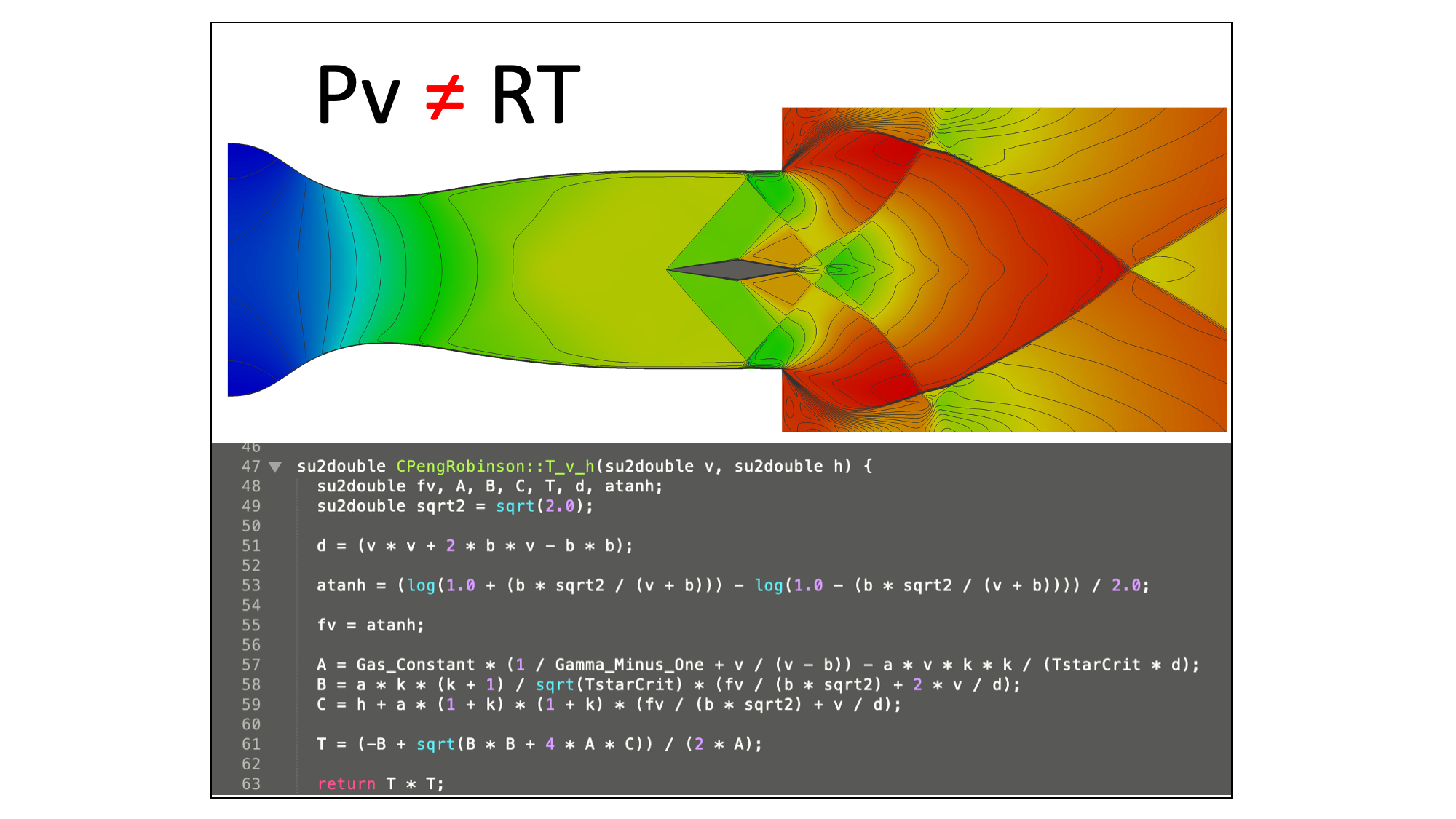
Non-Ideal Compressible Fluid-Dynamics (NICFD) is the branch of science devoted to the investigation of a particular class of fluids that, under certain thermodynamic condition, do not abide by the well-known ideal gas law. Namely, for such substances Pv ≠ RT, being P the pressure, v the specific volume, R the gas constant and T the temperature. Because of this, more accurate and complex fluid models need to be employed. Computational tools are typically developed with ideal gas applications in mind and, therefore, they become quite ineffective in the context of NICFD. Part my research effort is pledged to developing innovative computational tools specifically tailored to NICFD applications. For instance, thanks to a joint effort by Politecnico di Milano, TU Delft and Stanford University, in 2014 I contributed to extending the open-source SU2 software suite to perform turbulent Non-Ideal Compressible Fluid-Dynamics (NICFD) simulations [1]. I contributed in developing a built-in thermodynamic library, tightly coupled with the existing structure of the code which was properly re-organized for accommodating arbitrary thermophysical models. The library also implements an interface to an external software, FluidProp[2], giving access to state-of-the-art models for estimating the thermophysical properties of NICFD pure fluids and mixtures.
NICFD: Virtual Schlieren
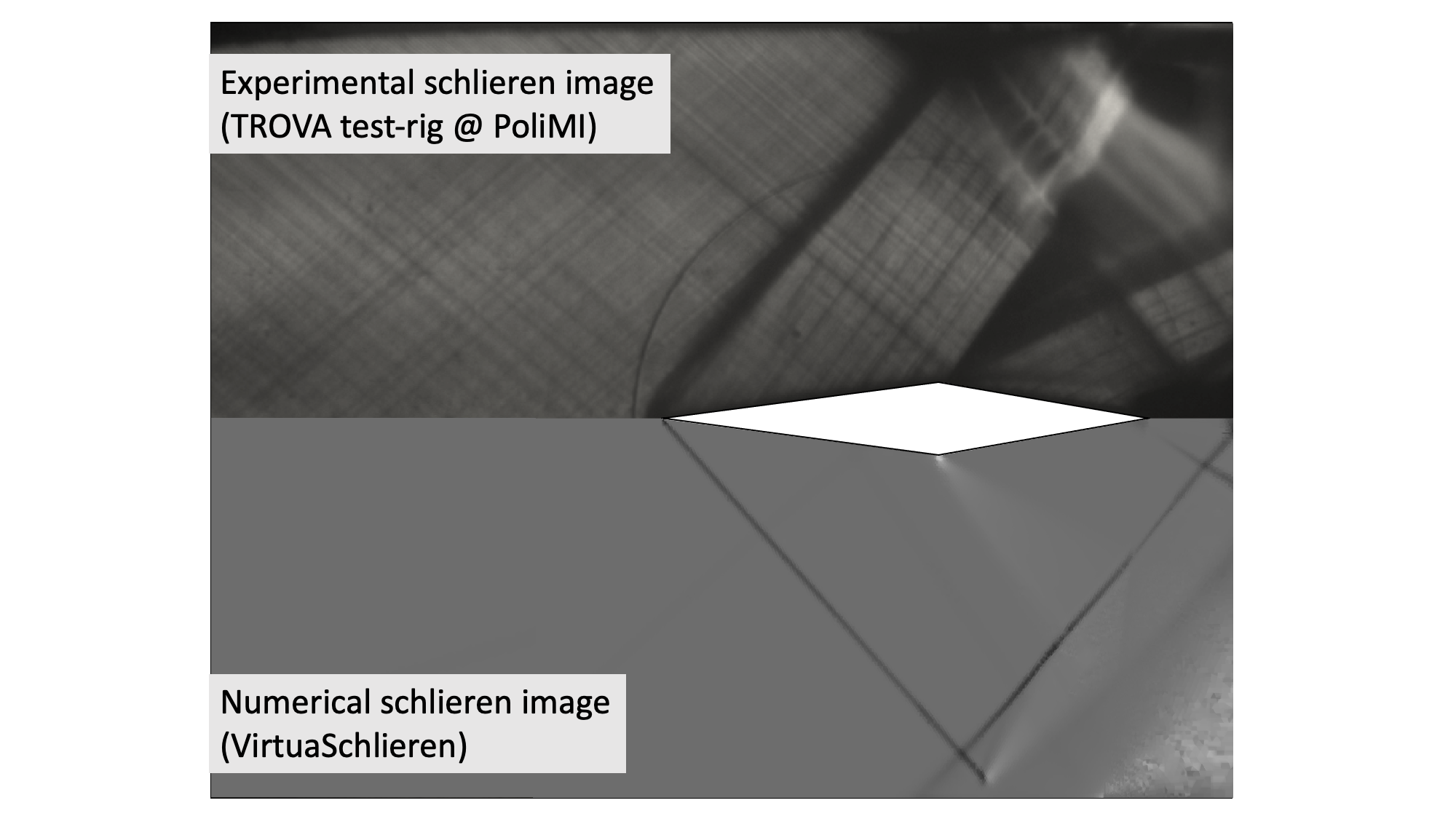
One of my research goals is to develop tools and techniques for integrating theoretical predictions, numerical simulations and experimental measurements, to tackle physical problems of ever-increasing complexity in the context of fluid mechanics. A good example is the development of CFD post-processing tools for comparing simulations against measurements obtained using the experimental schlieren visualization technique. Practically, a schlieren image is a photograph of the flow domain obtained through a particular apparatus. The picture is characterized by dark and bright areas which depend on the fluid density gradients encountered by light rays crossing the test section. The VirtuaSchlieren software is a hybrid GPU/CPU-based simulation tool for obtaining schlieren images from three-dimensional CFD simulations of variable density flows. The software is capable of simulating diverse experimental arrangements such as the single pass or the double-pass reflected schlieren apparatuses. Moreover, the VirtuaSchlieren software implements several diffraction models for Non-Ideal Compressible Fluid-Dynamics (NICFD) flows, making it a tool suitable for NICFD applications.
NICFD: software accuracy assessment

One of my activities consists in assessing the accuracy of computational models for Non-Ideal Compressible-Fluid Dynamics (NICFD) flows. Computational tools are of the utmost relevance for investigating fundamental physics, for calibrating thermodynamic models, for designing novel experiments and in Organic Rankine Cycle turbomachinery applications (design, optimization and performance assessment). A thorough accuracy assessment necessarily requires a formal and systemathic treatment of the uncertinay inherent the computational model, including its implementation within a computer program, and the uncertainty affecting the operating conditions of the test-rig employed to generate the validation data set. My interest is therefore oriented towards developing novel Uncertainty Quantification (UQ) techniques for handling large scale problems, with a special focus on the validation of NICFD and aeronautical CFD tools. In the past, I have been working on assessing the accuracy of the NICFD solver from the open-source SU2 software suite by taking advantage of the first-ever experimental measurements relative to compressible fluid flows in the non-ideal regime [1, 2, 3]. Measurements were obtained using the Test-Rig for Organic Vapour (TROVA).
Turbomachinery: sliding meshes
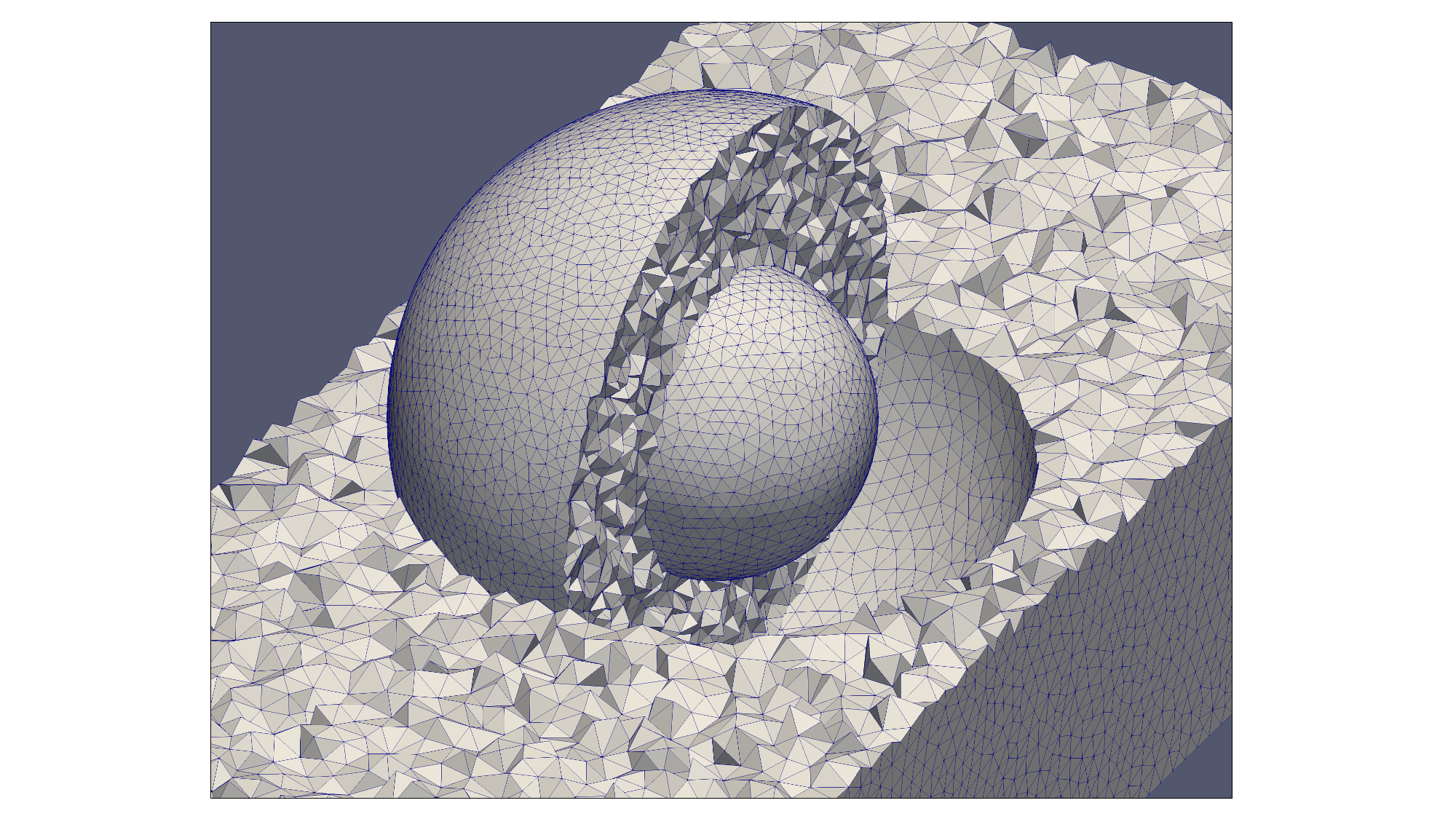
I have been working on developing numerical methods and tools for managing sliding meshes. The sliding mesh interface allows adjacent grids to slide relative to one another and it is of the utmost relevance in the context (but not limited to) of turbomachinery applications. Practically, the sliding mesh problem boils down to computing the flux across the interface between two non-conformal grids. The challenge lies in developing conservative methods that are able to handle curved sliding interfaces and domains discretized using multiple moving zones. In this context, I contributed in developing the open-source SU2 software suite by implementing several sliding mesh approaches.
Bayesian methods: model calibration and parameter inference
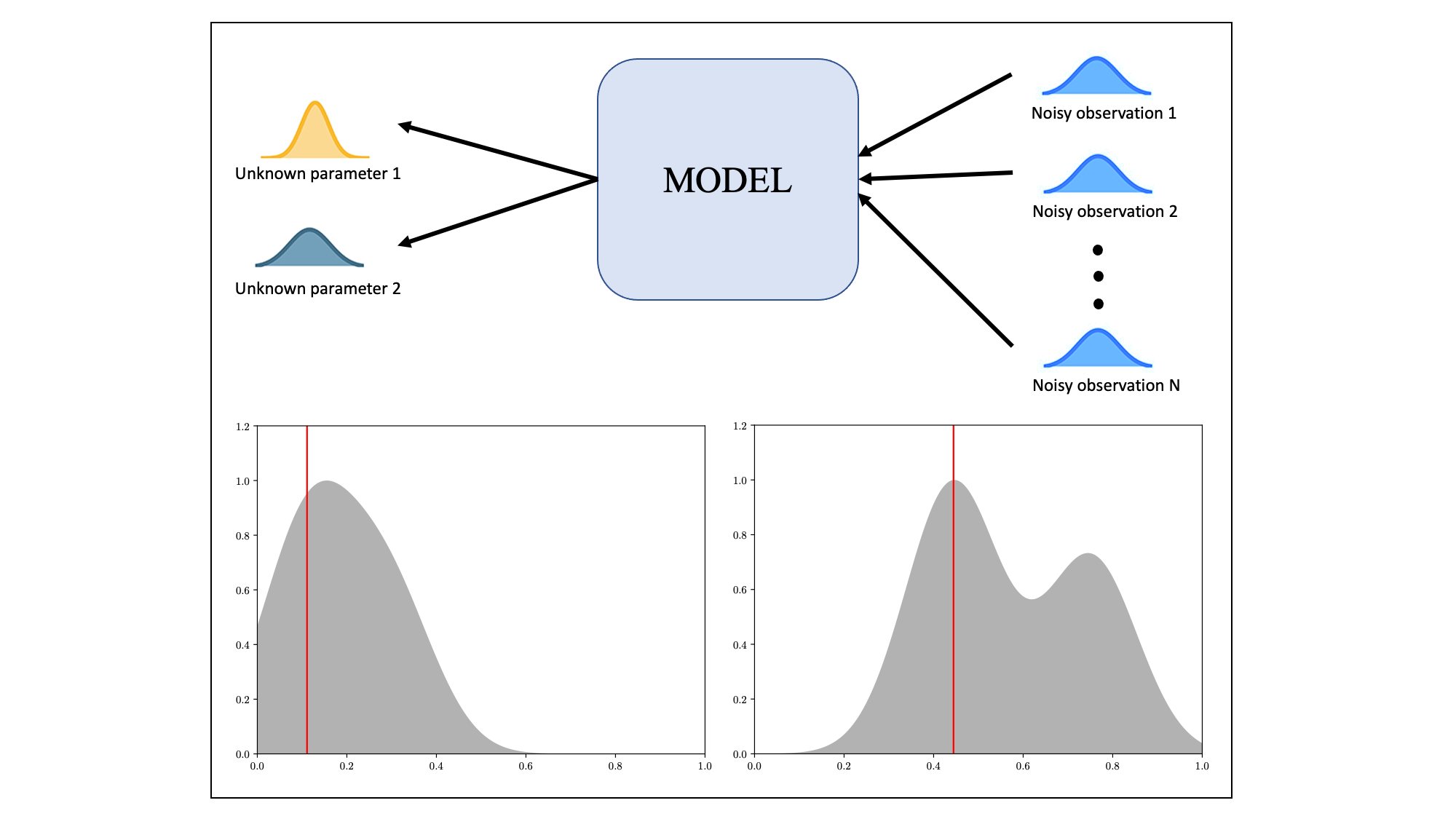
Computational Science aims at developing reliable and predictive numerical tools, relying on and exploiting the interactions between experiment, computation and theory. The objective is not only to numerically simulate an observed phenomenon with high-fidelity, but also to predict the reality in situations for which the numerical tool has not been specifically validated nor tested. Reliable numerical predictions require sophisticated physical models as well as a systematic and comprehensive treatment of calibration and validation procedures, including the quantification of inherent model uncertainties. This objective is particularly difficult with regard to complex multi-physics systems, for which the inference of parameters from noisy data in presence of model uncertainty remains a challenging task. In the context of Non-Ideal Compressible-Fluid Dynamics (NICFD), I have been concerned with the inference of the coefficients of state-of-the-art thermodynamic models for complex molecular compounds [1]. In the field of in-flight ice accretion, I have been working on the inference of the shape of falling snowflakes e.g., [2]. Another application of interest is the calibraiton of low-order aerodynamic models to improve the performances of unconventional aircraft tail configurations [3].
NICFD: non-ideal oblique shock waves
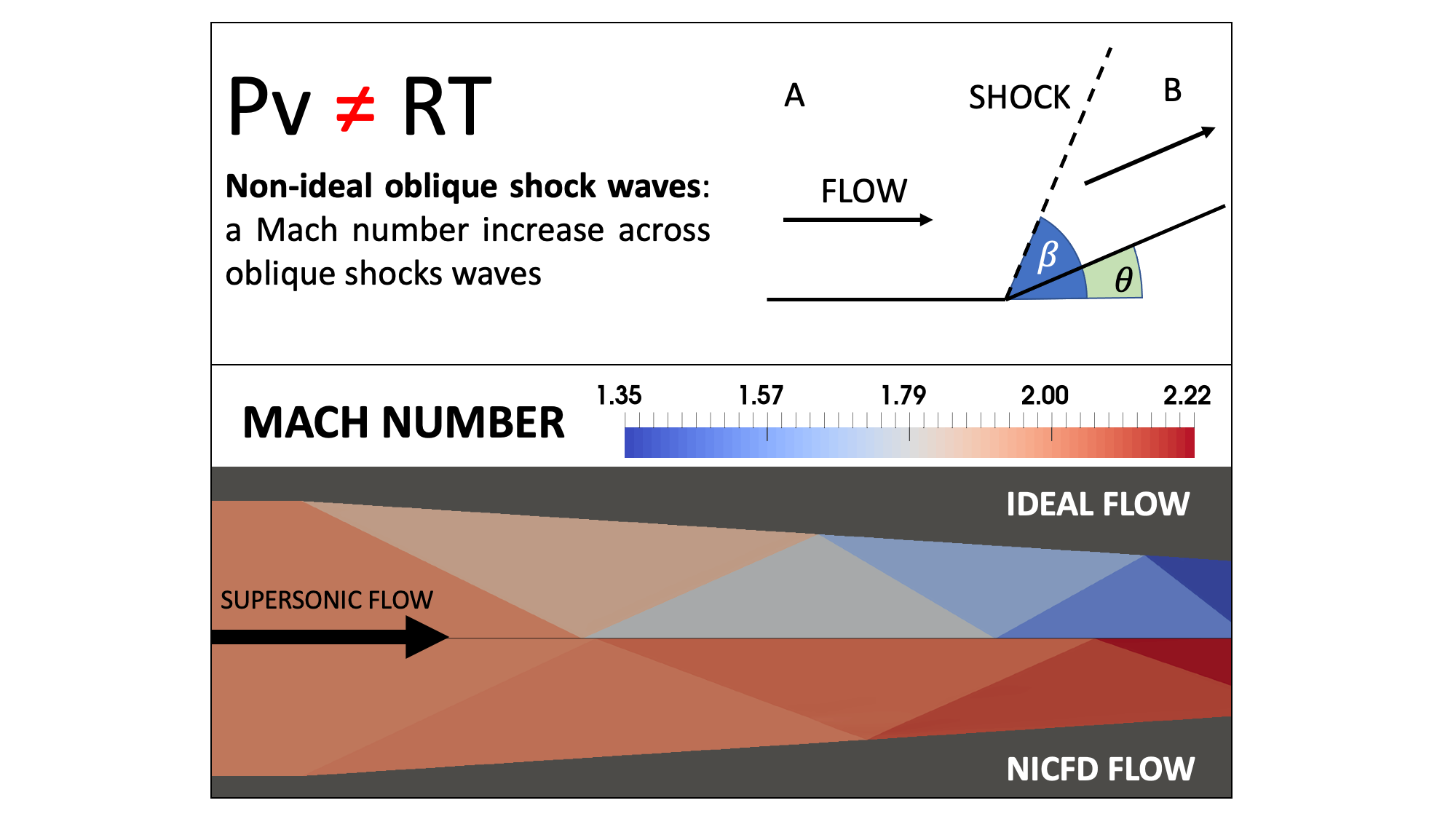
One of my major research purposes is the Scientific Modeling of Non-Ideal Compressible-Fluid Dynamics (NICFD) effects. In particular, I have been investigating the non-monotone dependence of the speed of sound along adiabatic transformations, demonstrating the admissibility of a non-ideal increase of the flow Mach number across oblique shock waves, for pre-shock states in close proximity of the liquid-vapour saturation curve [1, 2]. Oblique shock waves of finite amplitude in which the post-shock Mach number is larger than the pre-shock Mach number, named non-ideal oblique shocks, are admissible in substances characterized by moderate molecular complexity and, therefore, are of the utmost relevance for Organic Rankine Cycle (ORC) applications. Indeed, at the trailing edge of supersonic high-pressure turbine vanes, a typical shock pattern, the so-called fish-tail shocks, originates due to the flow rotation imposed by its finite thickness. ORC turbine stator blades are particularly prone to this phenomena since they are designed to provide a high outlet Mach number, especially at the first stage [3].
NICFD: measurement systems

I have been working on the characterization of the dynamic response of measurement tools, namely static pressure probes, in Non-Ideal Compressible-Fluid Dynamics (NICFD) applications [1, 2]. Time resolved measurements of fluid properties in highly unsteady flows are nowadays fundamental for turbomachinery design and development. Indeed, several phenomena related to the turbine stator-rotor interactions, such as wake transport and rectification, wake-induced boundary layer transition, vortex migrations and boundary layer shock-wave interaction, significantly affect the overall stage efficiency and have other consequences, including noise production and the generation of thermal stresses. The time-response of pressure probes largely depends on the thermo-physical properties of the target fluid. Generally, measurement devices are designed with ideal flows in mind and, naturally, the credibility of observations obtained in the NICFD regime is at least questionable. This problem is fundamental to Organic Rankine Cycle (ORC) turbomachinery applications since they employ molecularly complex compounds operating in non-ideal conditions. To extend the applicability of measurement and calibration techniques devised for dilute gases to NICFD flows, it is mandatory to carry out a careful investigation of the behavior of probes in the limit of non-ideal thermodynamics.
NICFD: ORC robust design and optimization
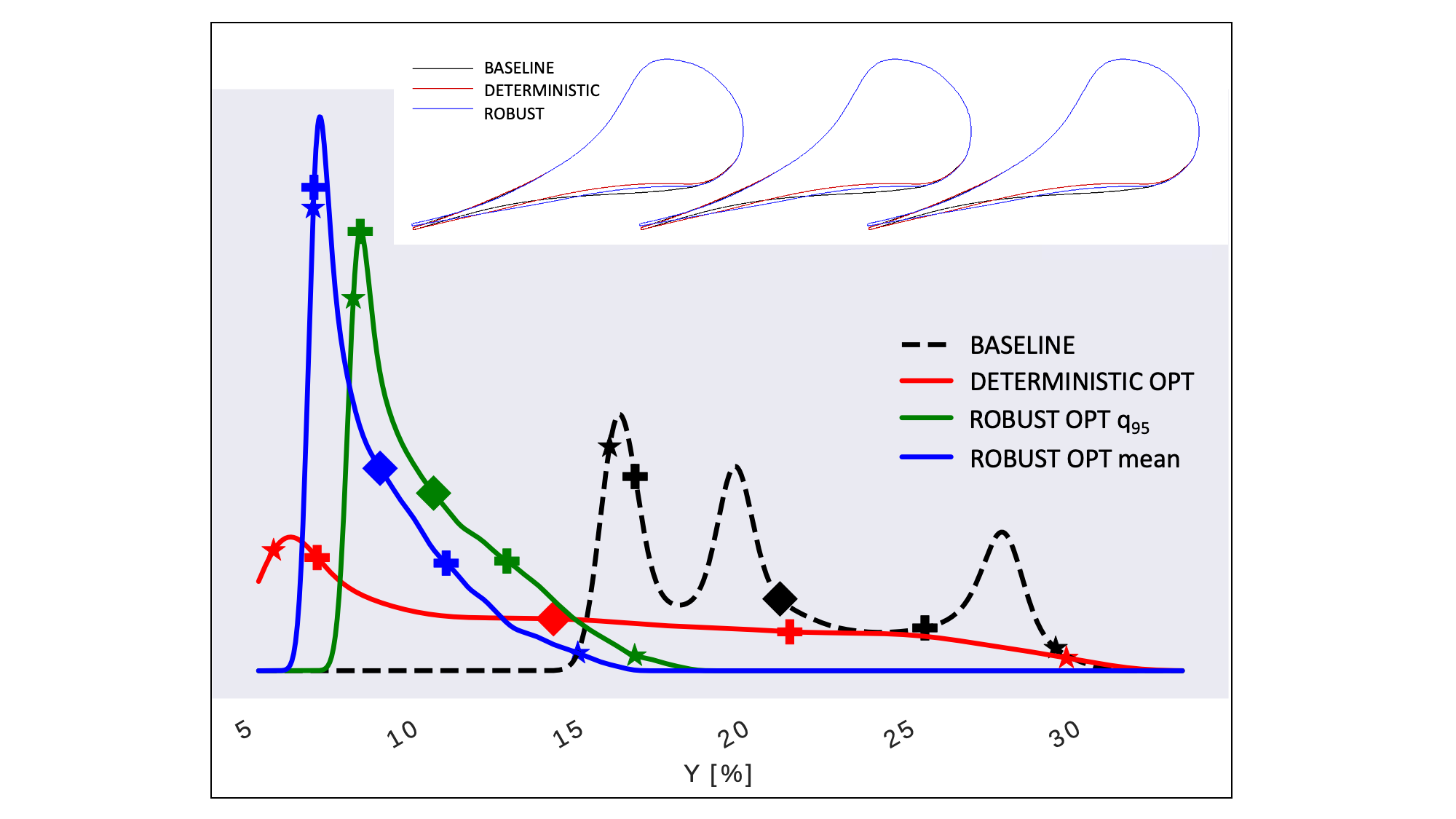
Organic Rankine Cycle (ORC) turbines usually operate in thermodynamic regions characterized by high-pressure ratios and Non-Ideal Compressible-Fluid Dynamics (NICFD) effects. These features significantly complicate the design process of turbomachinery elements i.e., blades and channelss. My research focus is on developing systematic optimization methods accounting for multiple uncertainties inherent the structure of the computational model and due to variable operating conditions. In particular, I have been developing Bayesian optimization methods and procedures to improve the efficiency of the design process by limiting the optimum search to the regions of the design space where predictions from the computational model are deemed credible [1, 2, 3, 4, 5].
High enthalpy flows: atmospheric entry
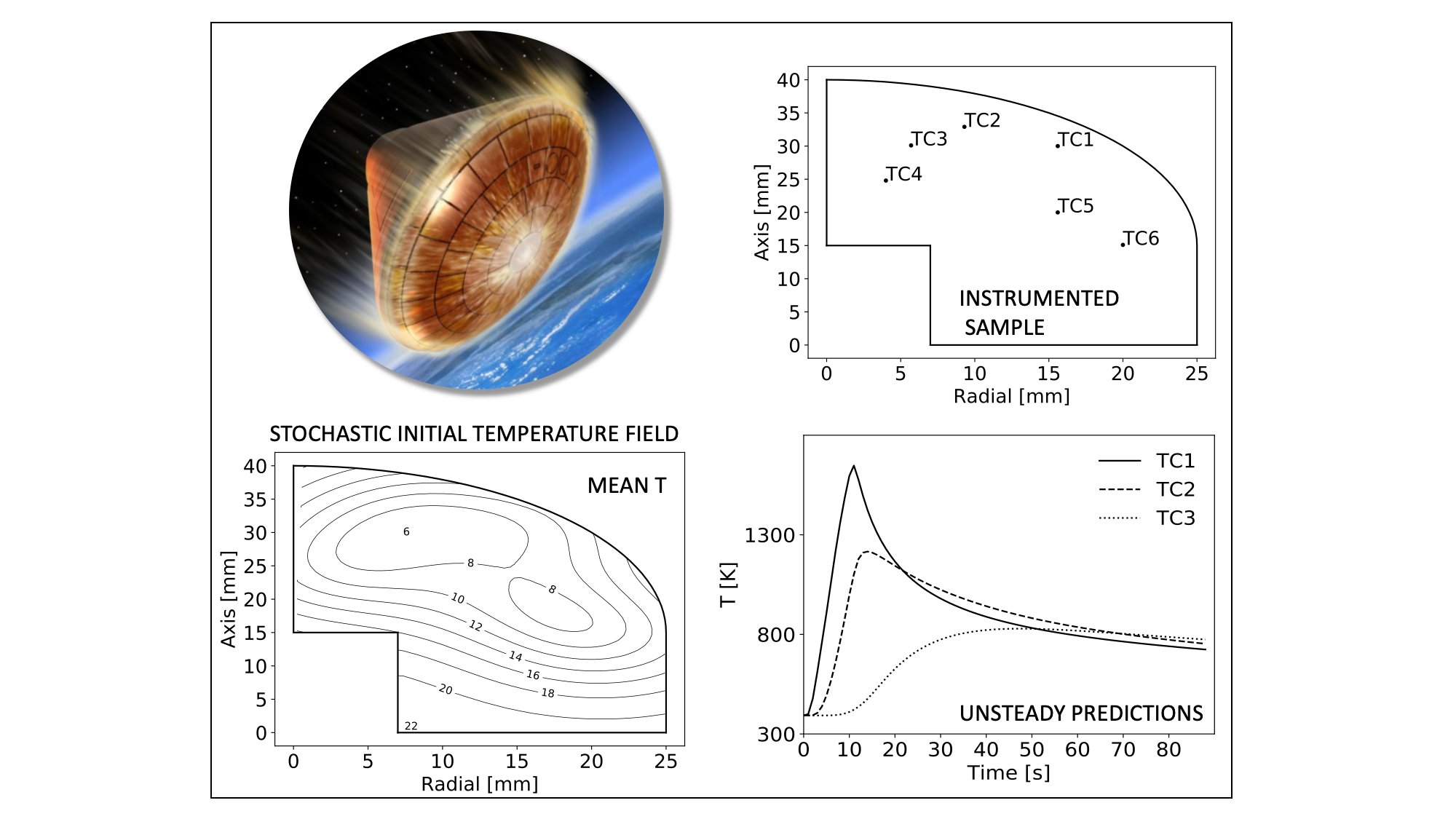
A spacecraft entering the atmosphere of a planet at a hypersonic velocity is exposed to very harsh conditions, not only because of a completely different fluid dynamics stability regime, but also because of extreme temperatures generated by aerodynamic friction heating and by exothermic chemical reactions occurring on the capsule external surface. Failing in protecting the spacecraft during the entry phase undoubtely leads to a catastrophic loss. The Thermal Protection System (TPS) is designed to ensure the safety of the payload and, above all, the occupants. The extreme conditions faced during the descent phase trigger a set of complex physical processes occurring either in the outer flow (e.g., real gas effects, low density effects, dissociation, ionization) and in the TPS itself (e.g. pyrolysis in carbon-phenolic ablative compounds). It follows that a thorough knowledge of the material thermal response to high heat loads is fundamental to properly design the spacecraft. The ultimate objective is not only to predict the material behavior with a high fidelity in particular conditions, but also to develop models which might be used to reasonably simulate the material response to unknown environments. Because the capabilities of ground facilities are limited, tests can only be carried out at specific conditions. Therefore, experiments can not reproduce many aspects of a real flight. In this perspective, it is my research interest to develop novel calibration and validation procedures to improve the accuracy of computational models. In particular, I have been concerned with numerically exploring the impact of the initial temperature field uncertainty on predictions from mathematical models devised to simulate the response of ablative material subject to extremely high heat loads [1].
High enthalpy flows: fundamental physics
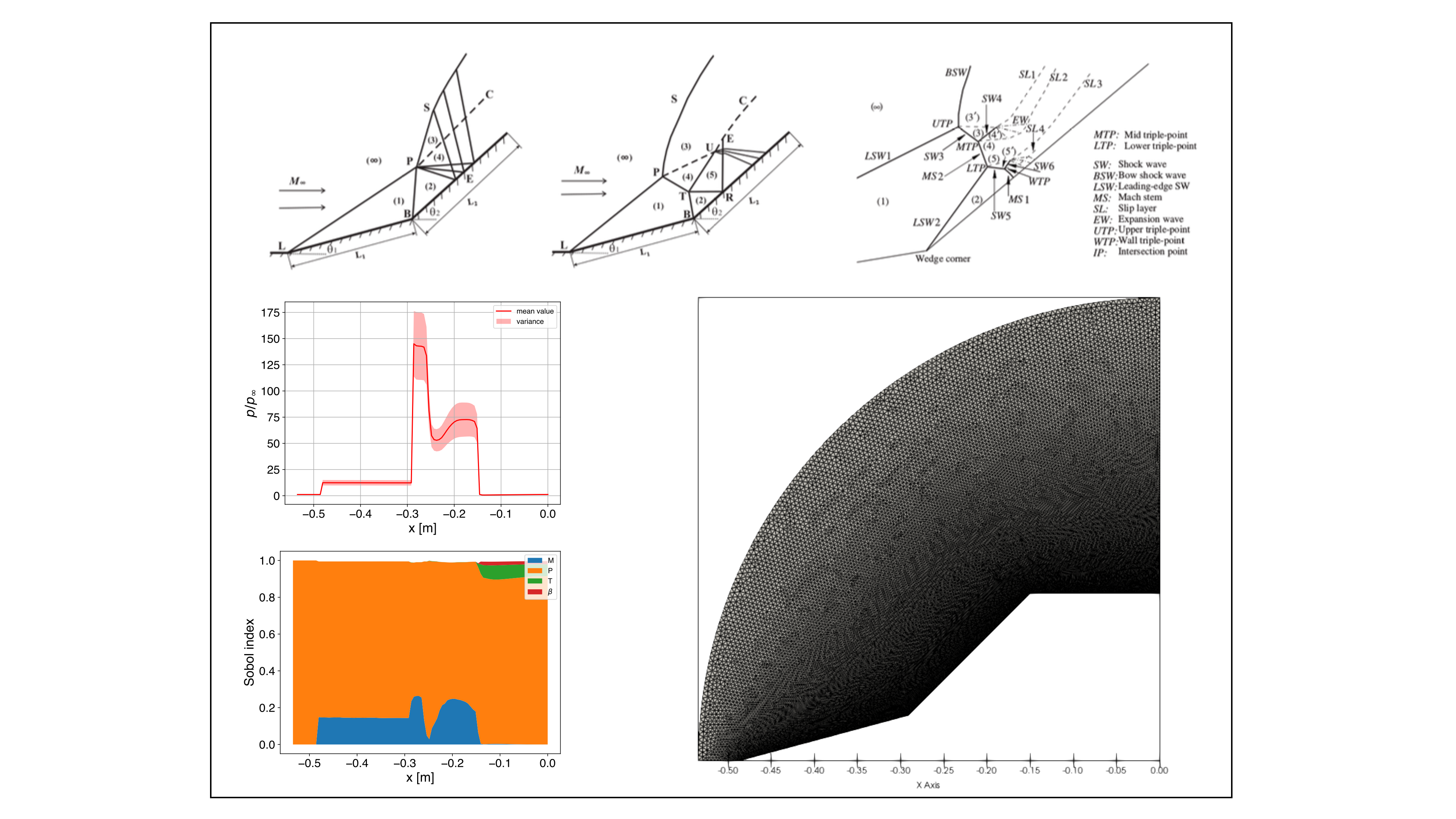
Hypersonic flight is of the utmost interest of both the Academic and the Industrial communities. Typical applications concern the atmospheric entry of a spacecraft or the powered flight of an aircraft at a high-altitude. The full scope of hypersonic applications spans orbital and suborbital missions entailing research, exploration, and tourism. These include manned spacecraft re-entering atmosphere, re-usable launchers, research and experimental devices, and sub-orbital vehicles. From a design standpoint, an accurate prediction of the complex physical phenomena characterizing hypersonic flight is mandatory for improving the design of vehicles operating in such regime. Besides, the optimization quest is made challenging by the uncertainty which unavoidable affects reality e.g., operating conditions, fluid chemical composition, or epistemic uncertainty inherent the computational model. The inability to deterministically handle hypersonic applications can lead to catastrophic failure, such as the case of the NASA X-15, where an unanticipated shock impingement, and the associated localized heating, caused a catastrophic structural failure. Therefore, hypersonic applications call for an assessment of the inherent uncertainty. In this regard, my research interest is devoted to investigating fundamental aspects related to how the uncertain flow parameters affect the shock pattern in nonequilibrium gas flows around different geometries e.g., [1].
Design: optimization and optimization under uncertainty
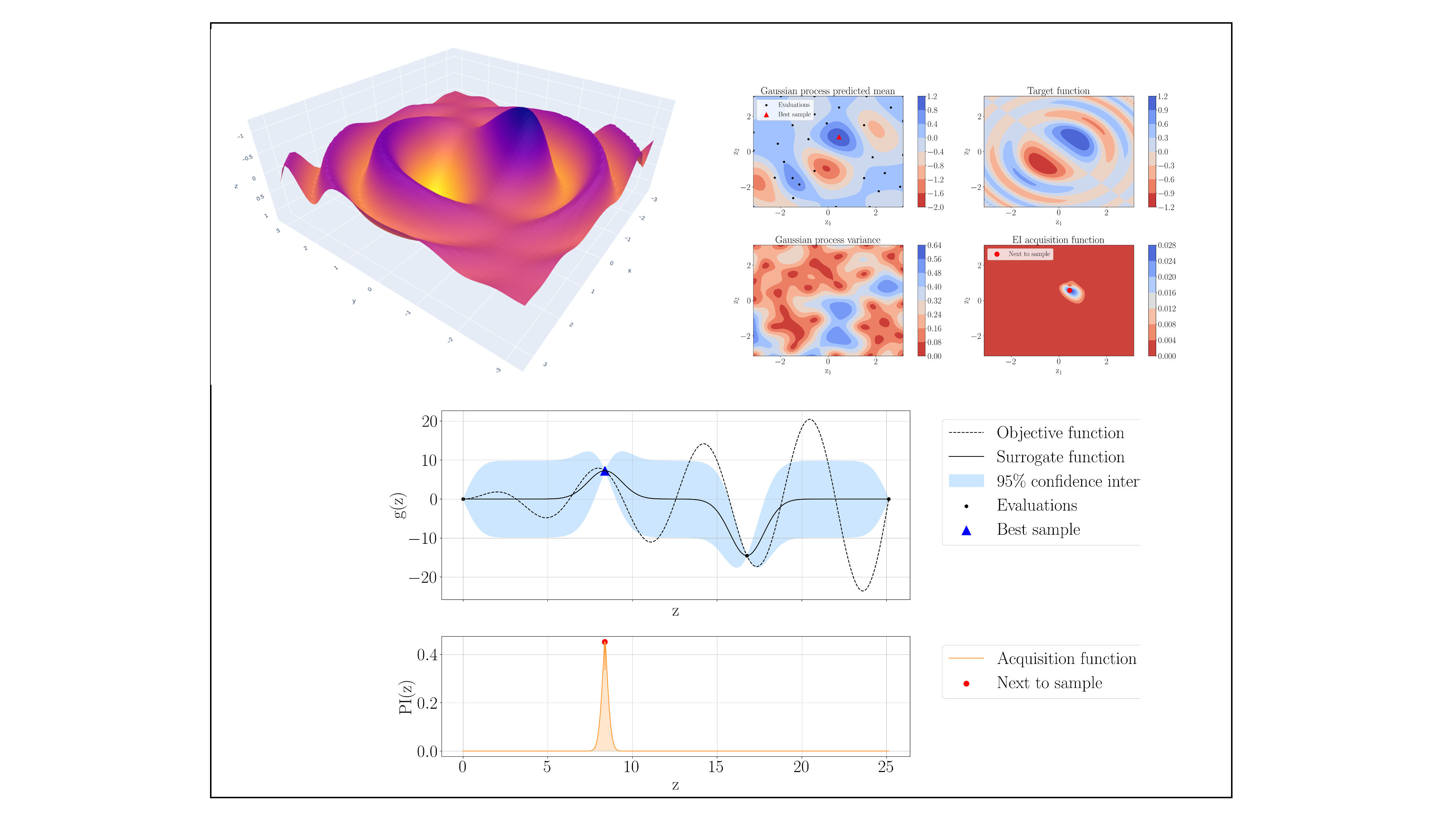
In Bayesian optimization, the design space is efficiently searched by taking advantage of the so-called acquisition function, an auxiliary mathematical object that aims at exploiting prior belief and available data. Different acquisition functions may be exploited, singularly or combined, to further improve the efficiency of the optimization. In view of investigating possible solutions to the issue of integrating the measure of turbulence modelform uncertainty into traditional design optimization frameworks, we explored several strategies for accounting for the credibility constraint when acquiring a new design point. e.g., [1]. Moreover, we explore the potential of multi-fidelity modeling methods to leverage on the concatenation of data sets presenting enormous diversity in terms of information, size, and behavior. Pieces of information of diverse fidelity and complexity complement each other, leading to improved estimate accuracy and to a minimization of the cost associated with parametrization. The applications of interest cover the design of thermal heat shield for hypersonic re-entry problems, turbomachinery, ice thermal protection systems, and the design of aeronautic vehicles e.g., [2, 3, 4].
Machine learning: data-driven models, physics informed surrogates, and multi-fidelity models
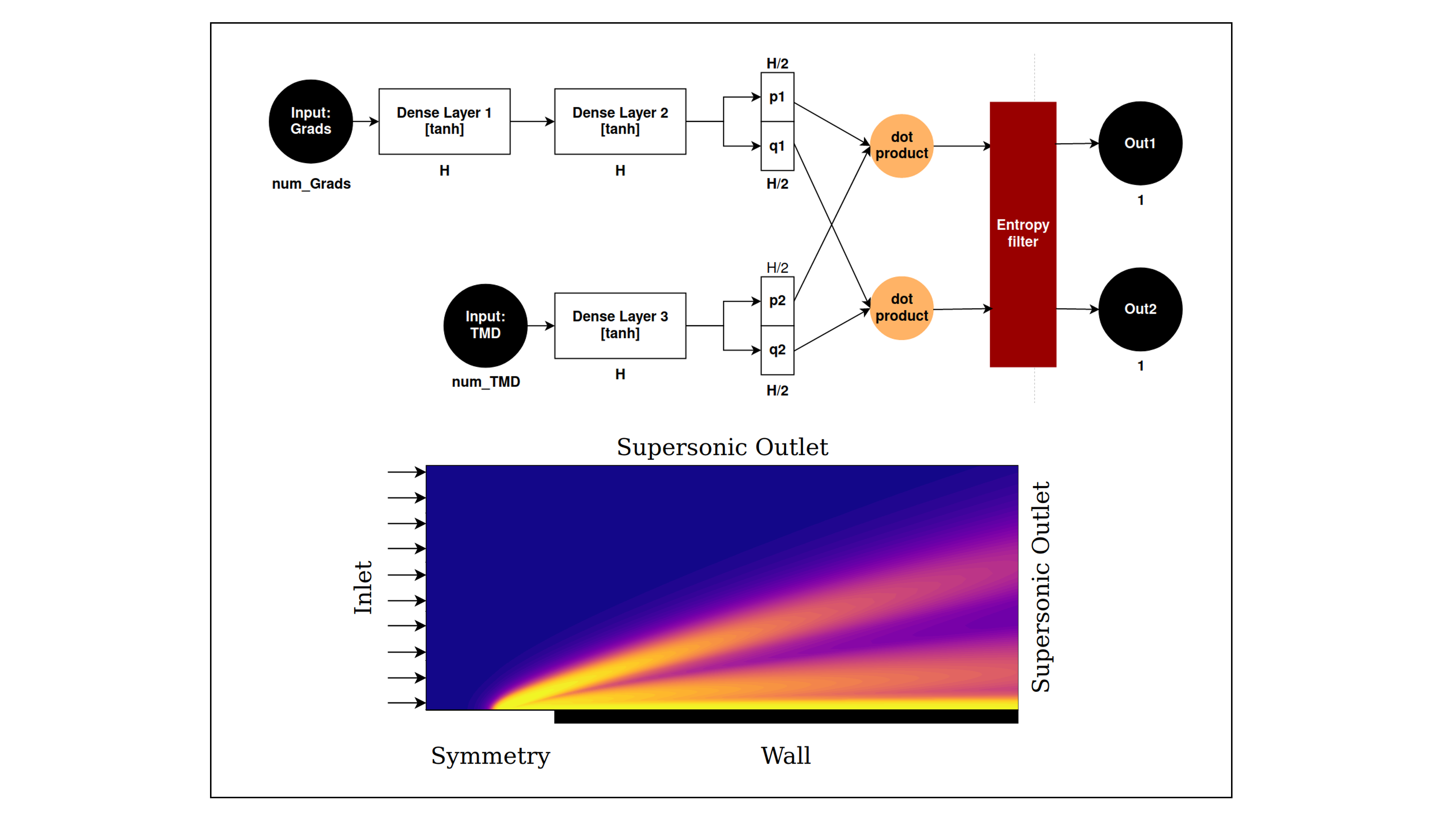
Innovative deep learning algorithm are proposed to extend the accuracy of the Navier-Stokes model. In particular, the target is focused on high-entalpy flows with the aim to improve the modeling of the translational regime. The approach under development relies on the addition of a neural network-based closure term that encodes any missing physics and ensures consistency with the balance equations. The pursued approach is based on the premise that the fundamental principles of physics are universal and must be enforced during the training process of deep learning models of general validity. The aim is a model that can capture the physics underlying the application together with the features encoded in the data, and not just to obtain a mere black-box closure that mimics a prescribed data set. Moreover, we explore the potential of multi-fidelity modeling methods to leverage on the concatenation of data sets presenting enormous diversity in terms of information, size, and behavior. Pieces of information of diverse fidelity and complexity complement each other, leading to improved estimate accuracy and to a minimization of the cost associated with parametrization. The applications of interest cover the design of thermal heat shield for hypersonic re-entry problems and the design of aeronautic vehicles e.g., [1].
Rotorcraft: aeroacoustics, design, and multi-fidelity models
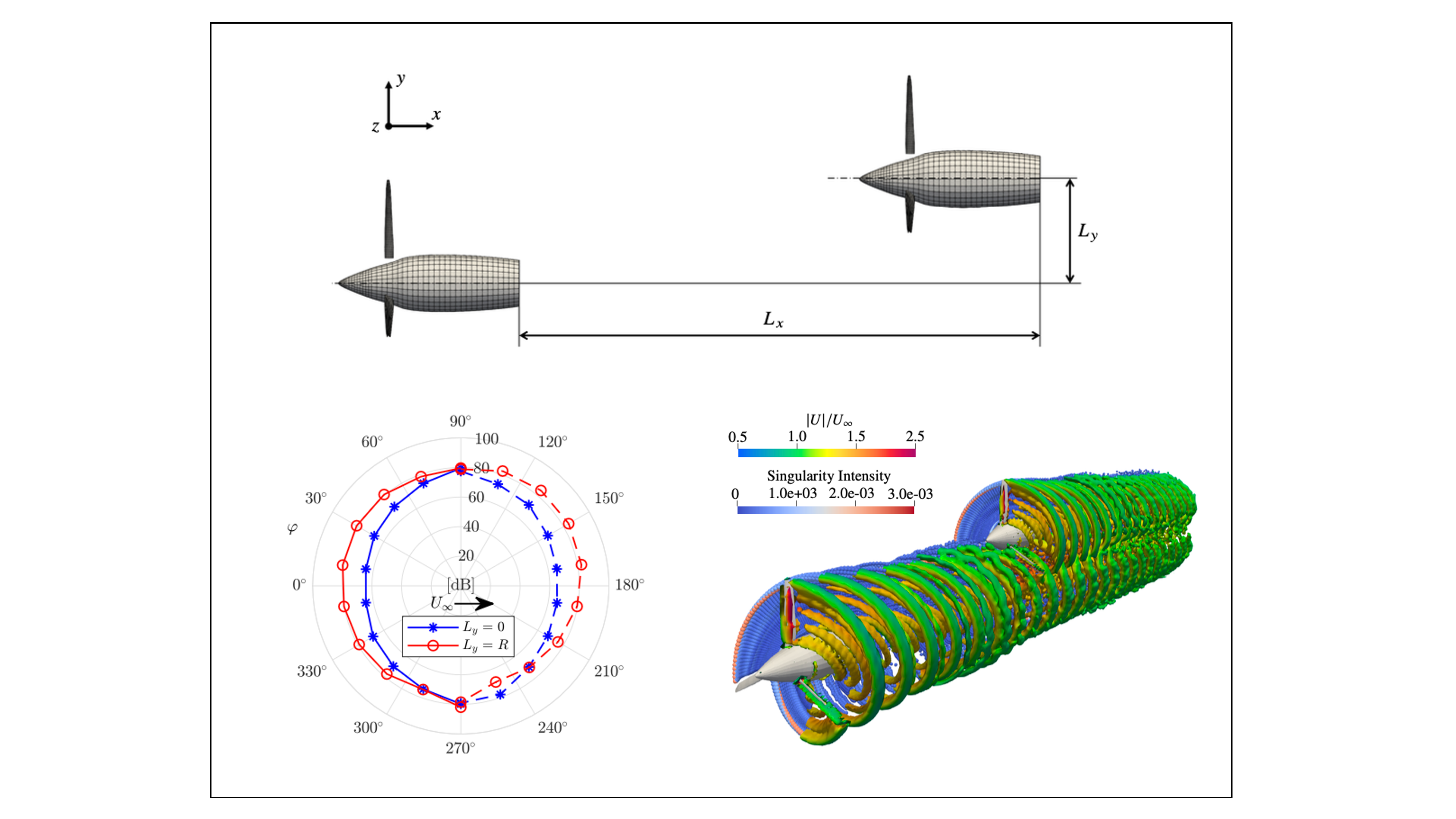
Innovative multi-fidelity methods for characterizing the aerodynamics and the aeroacoustics of multirotor systems with application to advanced eVTOL aircraft. In this framework, the goal of the activity is a multi-fidelity investigation of two propellers in tandem with rotor disks overlap, reproducing a typical feature of eVTOL architectures in airplane mode flight conditions. A Ffowcs Williams–Hawkings equation solver is used to compute the aeroacoustic footprint of the test case in different configurations. The solver is run with both mid-fidelity aerodynamic simulation data obtained with DUST and high-fidelity simulation data obtained with SU2 e.g., [1]. A multi-fidelity approach (mixed numerical and experimental data) is also used to calibrate and improve low-order aerodynamic models for predicting the performance of lifting surfaces. The calibration is attained using standard Bayesian inference methods. Related works are limited to the investigation of unconventional stationary lifting surfaces e.g., [2, 3, 4].